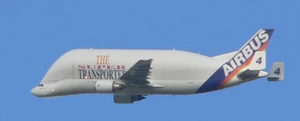| Airbus Beluga | ||
|---|---|---|
 Airbus Beluga in flight over Hamburg in old initial Airbus livery. | ||
| Description | ||
| Role | Outsize cargo freight aircraft | |
| Crew | 2 | |
| Passengers | No seats/passengers, cargo configuration | |
| First flight | 13 September 1994 | |
| Entered service | September 1995 | |
| Manufacturer | Airbus | |
| Produced | 5 | |
| Dimensions | ||
| Length | 184 ft, 3 in | 56.15 metres |
| Wingspan | 147 ft, 1 in | 44.84 metres |
| Height | 56 ft, 7 in | 17.24 metres |
| Wing area | 2,785.7 sq ft | 258.80 square metres |
| Weights | ||
| Empty | 86 t | |
| Loaded | ||
| Maximum takeoff | 155 t | |
| Powerplant | ||
| Engine | 2 × GE CF6-80C2A8 | |
| Power (each) | 52,500 to 63,500 lb | 234 to 282 kN |
| Performance | ||
| Maximum speed | ||
| Cruising speed | ||
| Range | 1,501 nmi (40 t payload), 2,501 nmi (26 t payload) | 2,779 kilometres (40 t payload), 4,632 kilometres (26 t payload) |
| Ceiling | ||
| Rate of climb | ||
The Airbus Beluga (or A300-600ST) is a heavy cargo aircraft developed by Airbus, a division of EADS. The Beluga was designed to carry parts of Airbus aircraft around the globe to positions of multiple final assembly lines.
History[]
The Beluga was developed by SATIC to meet a requirement for a new type, to replace the fleet of Super Guppy aircraft used to transport components for Airbus airliners from the factories to the assembly plants. The Airbus A300 was used as the basis for the new type, which featured an enlarged upper fuselage and a relocated cockpit section, placed below and ahead of the forward cargo hold door, which allows the payload to be rolled on and rolled off.[N 1]
The first flight took place on 13 September 1994, and lasted 4 hours and 23 minutes. The certification process, which included 400 hours of flight time, was completed in September 1995, and led to the first of five examples for Airbus Industrie being delivered in January 1996. The fleet was completed by delivery of the fifth example in December 2000.[2]
Note[]
The type was named Beluga due to it's resemblance to the Beluga whale.
References[]
Notes[]
Sources[]
- ↑ World Aircraft & Systems Directory - First Edition. Brassey's (UK) Ltd. 1996. ISBN 1 85753 198 1 Page 296
- ↑ WA&SD 3 Page 671